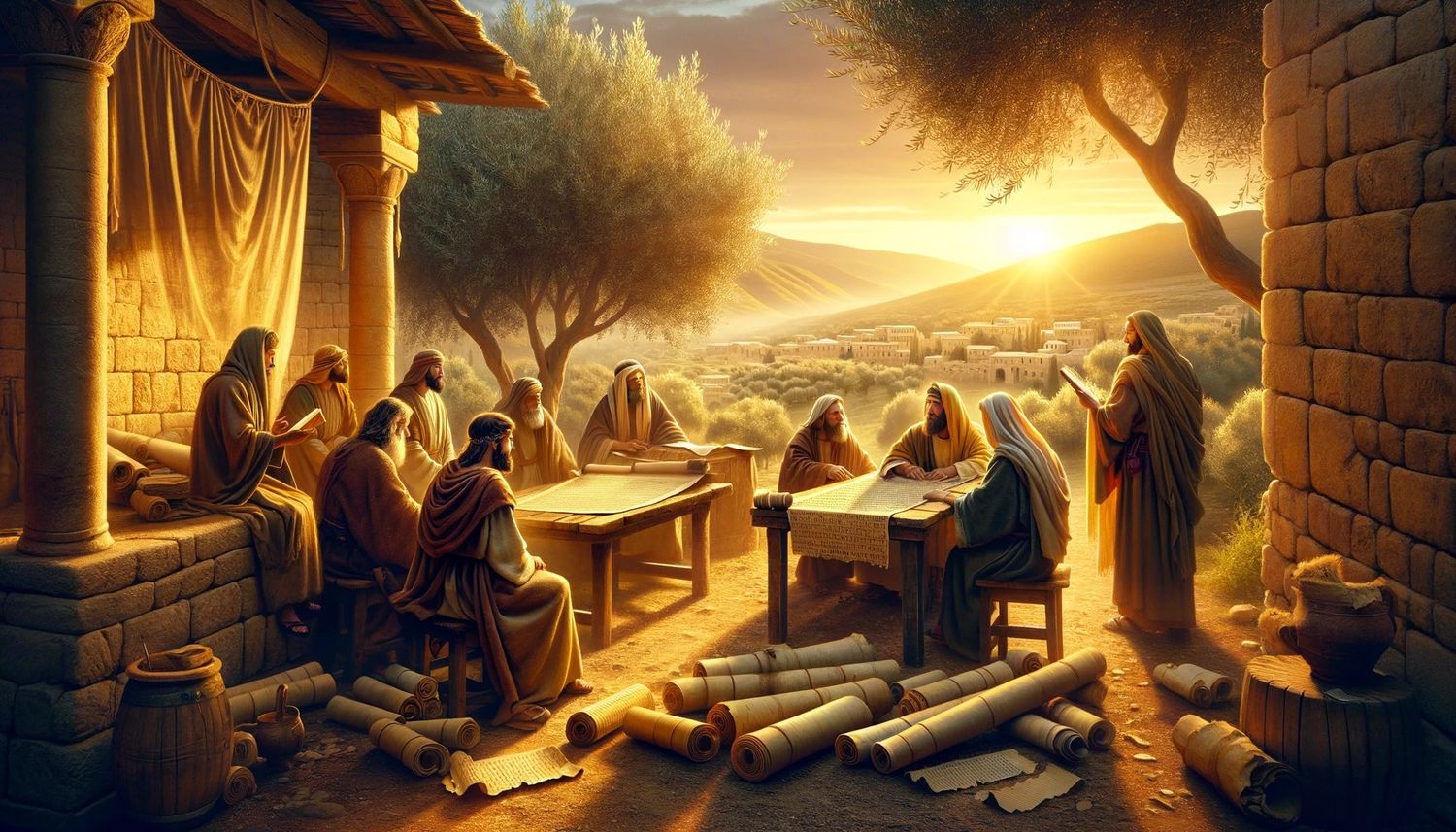Home>Christian Videos>Bible Stories>Why Were Some Gospels Not Included In The Bible


Bible Stories
Why Were Some Gospels Not Included In The Bible
Published: March 5, 2024
Jason DeRose, Managing Editor at Christian.net, uses his expertise in religion and journalism to deepen understanding of faith's societal impacts. His editorial leadership, coupled with a strong academic background, enriches the platform’s diverse content, earning him recognition in both journalism and religious circles.
Explore the reasons why certain gospels were excluded from the Bible and uncover the significance of these lesser-known Bible stories. Delve into the history and impact of these omitted texts.
(Many of the links in this article redirect to a specific reviewed product. Your purchase of these products through affiliate links helps to generate commission for Christian.net, at no extra cost. Learn more)
Table of Contents
Introduction
Ever wondered why some gospels didn't make it into the Bible? It's a question that has intrigued scholars and believers alike for centuries. The Bible, as we know it today, contains 66 books in total, but there are numerous other ancient texts that claim to offer insights into the life and teachings of Jesus Christ. So, why were some of these gospels not included in the Bible? Let's delve into the fascinating world of ancient religious texts to uncover the reasons behind the exclusion of certain gospels from the biblical canon.
Read more: Reasons Why The Gospels Were Written
The Gospel of Thomas
The Gospel of Thomas is a collection of sayings attributed to Jesus, believed to have been written in the 2nd century. Unlike the four canonical gospels, which focus on the life, death, and resurrection of Jesus, the Gospel of Thomas consists primarily of 114 sayings or logia. These sayings are presented as the secret teachings of Jesus, meant for his inner circle of disciples. The Gospel of Thomas offers a unique perspective on Jesus' teachings, emphasizing the importance of self-discovery and spiritual enlightenment. However, despite its intriguing content, the Gospel of Thomas was not included in the New Testament for several reasons.
Reasons for Exclusion:
-
Late Authorship: The Gospel of Thomas was written much later than the canonical gospels, raising questions about its authenticity and authorship. Its composition in the 2nd century placed it outside the timeframe of the original apostles and eyewitnesses to Jesus' ministry, leading early church leaders to view it with skepticism.
-
Gnostic Influence: The Gospel of Thomas reflects Gnostic beliefs, which were considered heretical by the early Christian church. Gnosticism emphasized the acquisition of secret knowledge for salvation, a concept that clashed with orthodox Christian teachings. The Gnostic influence in the Gospel of Thomas made it controversial and led to its exclusion from the biblical canon.
-
Lack of Narrative Content: Unlike the canonical gospels, the Gospel of Thomas lacks a narrative framework and historical context for Jesus' teachings. Its focus on individual sayings, detached from the events of Jesus' life, made it less suitable for conveying the foundational Christian message of salvation through Christ's life, death, and resurrection.
Despite its exclusion from the New Testament, the Gospel of Thomas remains a significant historical and theological document, shedding light on the diverse range of early Christian beliefs and interpretations of Jesus' teachings. While it may not be considered canonical, the Gospel of Thomas continues to spark scholarly debate and interest in understanding the complexities of early Christian thought.
The Gospel of Mary
The Gospel of Mary, also known as the Gospel of Mary Magdalene, is an ancient text that has garnered significant attention due to its portrayal of Mary Magdalene as a prominent disciple of Jesus. This gospel, believed to have been composed in the 2nd century, presents dialogues between Mary Magdalene and the other disciples, shedding light on her unique relationship with Jesus and her spiritual insights. Despite its intriguing content, the Gospel of Mary was not included in the New Testament for various reasons.
Reasons for Exclusion:
-
Late Authorship: Similar to other non-canonical gospels, the Gospel of Mary was written at a later date than the four canonical gospels, raising concerns about its historical accuracy and authorship. The early church leaders prioritized texts that were closely connected to the apostolic era, and the Gospel of Mary did not meet this criterion.
-
Gnostic Influence: The Gospel of Mary exhibits traces of Gnostic themes, including the concept of secret knowledge and the spiritual elevation of Mary Magdalene. These Gnostic elements were at odds with the orthodox Christian beliefs upheld by the early church, leading to the gospel's exclusion from the biblical canon.
-
Elevation of Mary Magdalene: The portrayal of Mary Magdalene as a central figure in the Gospel of Mary diverged from the traditional narratives found in the canonical gospels. This emphasis on Mary Magdalene's role and teachings may have been perceived as a challenge to the established hierarchy within the early Christian community, contributing to the gospel's non-inclusion in the New Testament.
Despite its absence from the biblical canon, the Gospel of Mary continues to captivate scholars and readers, offering insights into the diverse perspectives on Jesus' ministry and the evolving roles of individuals within the early Christian movement. The gospel's portrayal of Mary Magdalene as a significant disciple has sparked discussions about gender dynamics and leadership in early Christianity, making it a valuable resource for understanding the complexities of the early Christian tradition.
Read more: How Were The Gospels Written
The Gospel of Judas
The Gospel of Judas is a remarkable ancient text that offers a controversial portrayal of Judas Iscariot, one of the twelve disciples of Jesus. This gospel, believed to have been composed in the 2nd century, presents Judas not as a traitor, but as a favored disciple entrusted with a secret knowledge that enabled him to fulfill a divine mission. The Gospel of Judas provides a unique perspective on the events leading to Jesus' crucifixion and challenges the traditional narrative found in the canonical gospels. Despite its intriguing content, the Gospel of Judas was not included in the New Testament for several reasons.
Reasons for Exclusion:
-
Gnostic Influence: Similar to other non-canonical gospels, the Gospel of Judas reflects Gnostic influences, emphasizing the acquisition of secret knowledge for spiritual enlightenment. This divergent theological perspective clashed with the orthodox Christian beliefs upheld by the early church, leading to the gospel's exclusion from the biblical canon.
-
Unconventional Portrayal of Judas: The Gospel of Judas presents Judas Iscariot in a radically different light, depicting him as a figure chosen to facilitate Jesus' sacrificial mission. This portrayal contradicted the traditional understanding of Judas as the betrayer of Jesus, creating theological tensions that contributed to the gospel's non-inclusion in the New Testament.
-
Late Discovery and Translation: The Gospel of Judas was discovered in the 1970s in Egypt and subsequently translated and published in the 21st century. Its late emergence into the scholarly and public domain meant that it did not undergo the same level of scrutiny and acceptance as the canonical gospels, impacting its status within the Christian tradition.
Despite its absence from the New Testament, the Gospel of Judas continues to intrigue scholars and theologians, prompting discussions about the diversity of early Christian beliefs and the complexities of interpreting historical figures within religious texts. The gospel's portrayal of Judas Iscariot challenges traditional assumptions and invites reflection on the multifaceted nature of religious narratives and their enduring impact on faith and interpretation.
The Gospel of Peter
The Gospel of Peter is an ancient text that provides a narrative account of the crucifixion and resurrection of Jesus Christ. Believed to have been composed in the 2nd century, this gospel offers a detailed portrayal of the events surrounding Jesus' trial, crucifixion, and the subsequent discovery of the empty tomb. Despite its vivid depiction of these pivotal moments in Christian theology, the Gospel of Peter did not find its place within the New Testament for various reasons.
Reasons for Exclusion:
-
Non-Canonical Nature: The Gospel of Peter, like other non-canonical gospels, was not included in the New Testament due to its status as an apocryphal text. Early church leaders and councils, such as the Council of Nicaea, carefully evaluated and selected the texts that aligned with orthodox Christian doctrine and were deemed authoritative for the faith community. The Gospel of Peter did not meet the criteria for inclusion in the biblical canon, leading to its exclusion from the official collection of sacred scriptures.
-
Theological Discrepancies: The Gospel of Peter contains theological and narrative discrepancies when compared to the four canonical gospels. Its portrayal of the crucifixion and resurrection differs in certain details, raising concerns about its consistency with the established accounts of these foundational events in Christian belief. The early church prioritized texts that harmonized with the theological framework of the apostolic tradition, contributing to the Gospel of Peter's non-inclusion in the New Testament.
-
Limited Endorsement: Unlike the four canonical gospels, the Gospel of Peter did not receive widespread recognition and endorsement by early Christian communities. Its circulation and acceptance among various Christian congregations were limited, impacting its perceived authority and influence within the broader tradition. The absence of widespread acknowledgment hindered the gospel's candidacy for inclusion in the New Testament.
Despite its exclusion from the biblical canon, the Gospel of Peter remains a valuable historical and literary resource, offering insights into the diverse expressions of early Christian faith and the evolving narratives surrounding Jesus' life and ministry. While it may not be considered part of the authoritative scriptures, the Gospel of Peter contributes to the ongoing scholarly exploration of the rich tapestry of early Christian literature and the complexities of shaping the biblical canon.
Read more: How Were The Gospels Developed?
Conclusion
In conclusion, the exclusion of certain gospels from the New Testament was influenced by a combination of factors, including theological considerations, historical context, and the preservation of orthodox Christian beliefs. The Gospel of Thomas, the Gospel of Mary, the Gospel of Judas, and the Gospel of Peter, among others, offer diverse perspectives on the life and teachings of Jesus Christ, reflecting the rich tapestry of early Christian thought and expression. While these non-canonical gospels were not incorporated into the official biblical canon, they continue to stimulate scholarly inquiry and provide valuable insights into the complexities of early Christian literature and theology. The study of these ancient texts contributes to a deeper understanding of the diverse beliefs and interpretations that characterized the formative period of Christianity, enriching our appreciation of the multifaceted nature of religious traditions and their enduring impact on faith and culture.













